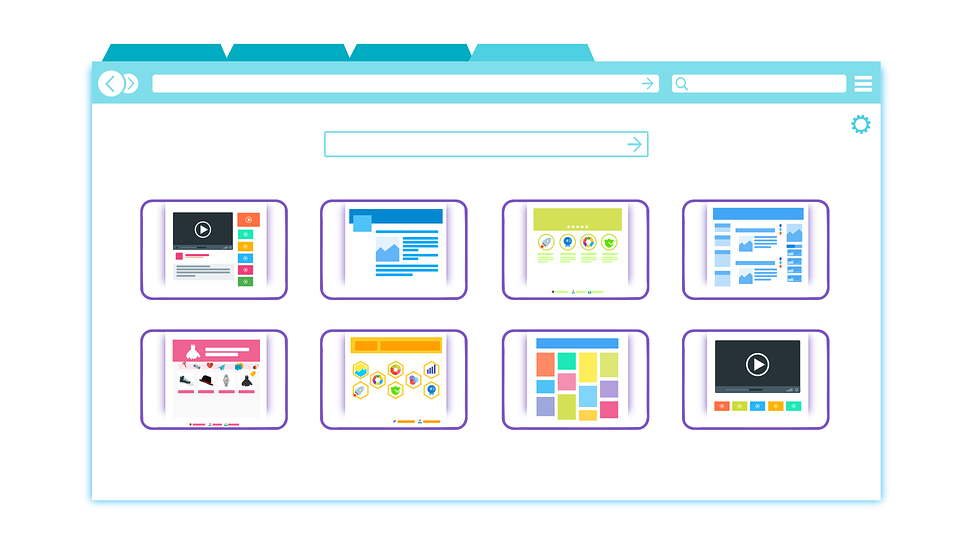U.S. consumers spent $100 billion during the first quarter of 2018, a 4.1% increase over the same period in 2017 and an all-time record for e-commerce. This is a sign of what to expect for Q1 2019, as we see that e-commerce becomes more and more integral to a retail business.
Retail e-commerce sales are forecasted to surpass $684 billion in 2020 – showing that retailers simply cannot afford not to sell online. But what’s the right way to go about doing so? It starts with the e-commerce website itself. Follow this guide on how to start an e-commerce website.
Designing Your E-commerce Website
Your e-commerce website is the ‘face’ of your retail store online, and its look, feel and user experience are just as powerful as your storefront for attracting and retaining customers. In fact, a website gives you far more opportunity to generate revenue, since you’re not nearly as limited to your geographic region or location.

Website design plans.
1. Choose your e-commerce platform and/or content management system (CMS).
There are dozens of CMS platforms for managing and building your e-commerce store, but a few stand out from the rest. As you make your choice, seven (7) of the most important factors to consider (in addition to price and functionality) are:
- Growth: If the platform does not support expansion or lots of additional SKUs, or only handles products of a limited type, you’ll want to consider whether your business can grow and continue to use your original e-commerce platform of choice. If not, a different, more flexible platform may be preferable. Some platforms are also best for selling specific products, and others are better for more or fewer quantities of SKUs or orders.
- Integrations: From connecting your sales to your accounting software, to running marketing campaigns in various tools, integrations are going to be critical for organization, seamless flow of data, and other aspects to running your e-commerce business. Most platforms accommodate a wide range of integrations with tools, relevant platforms and plugins, but not all will support your must-have ones, so be sure to confirm before you make your choice.
- Hosting: Some e-commerce platforms include secured hosting for your website, while for others, it’ll be a separate service that requires a third party to provide. You’ll have to weigh the pros and cons for your particular business model and partnership options.
- Payment & Shipping: The method of payment and partners for shipping are also very important parts of your decision for the best e-commerce platform. Compare the options and compatibility of payment methods (for 3rd party processors), and be sure to check on how shipping is handled. It will be important to choose an e-commerce platform that has at least the most popular shipping methods such as UPS, FedEx and USPS – 2-3 day shipping will be an expectation for most customers.
- Customer Support: Whether you have skills as a web developer and you know CSS, or technology and gadgets are a struggle, you’re probably going to need web support or input from an expert. Look into the customer service offerings, guarantees and any reviews from their other customers to see if they will be a good fit.
-

Securing your customers’ sensitive data is vital.
Security: Your e-commerce website will be accepting payment in some form, and therefore, security is vital. Level 1 PCI compliance is a mandatory standard with any payment processing platform you use, and you will want your e-commerce platform to support the elevated security involved in securing your customers’ sensitive data.
[ Related: Best E-Commerce Payment Options ]
- Budget: Price will always be a concern, no matter how fluid your cash flow is, so it will certainly be a consideration as you choose your platform.
[ Related: 10 Best E-Commerce Platforms for Businesses ]
2. Achieve brand identity and consistency with your domain name.
Whether you have an existing business or this e-commerce store is brand new, your domain name should reflect your brand identity. Choose a domain name that increases the awareness to your brand and won’t be confused with something else, earns your customers’ trust, and can be remembered (short and catchy ones are best). Be hesitant to restrict your business opportunities by choosing a domain that’s limited to a specific product offering (i.e. qualityblueshoes.com).
3. Design your website with your customers as a focus.
Even if you use a template, be sure to customize the design with your own branding and unique look. Your e-commerce website is the visual representation of your store, but the online version – make sure it stands apart! As part of your design process, you should take the time to identify your target market so that the website appeals to them and is easiest for them to navigate.
4. Use clear, concise calls to action.
Aside from your online store itself, the calls to action such as “shop”, “buy”, “browse” and others will help to drive more sales. Don’t confuse shoppers by including too many on each page, and think with your customers’ shopping habits in mind – add-on items and related products are great to link to and showcase. Keep your desired outcomes in mind as well; do you want customers to sign up to receive your newsletter so that you can advertise to them in other ways? Do you want them to read and engage with your blog content? Use CTAs for these actions as well.
5. Keep your website fast and lightweight.
Lots of functionality and bells and whistles will slow down your site (which may cause some customers to give up and go elsewhere). Minimize the extra plugins and features that your site contains to keep things running smoothly, but don’t forget to include a Search option, which is very important so that shoppers can find what they are looking for.

Different website designs will create different experiences for your customers.
6. Pay extra attention to the product descriptions.
Your text descriptions for the products you sell are probably one of the most undervalued aspects of marketing at your fingertips. They can help drive search engine traffic to specific products, in addition to providing a better representation of the product for potential customers. As much detail as you can include, the better – dimensions, special features, size accuracy for fit, assembly instructions, etc.
7. Ensure site security at all times.
Because your site is supporting payments and financial transactions, security is paramount. Not only do you want to make sure that your website is up and running 24/7 so that you can make sales at all times (after all, that’s one of the perks of having an online store), you also want to be sure your customers’ sensitive information is protected. Be sure to use a Secure Socket Layer (SSL) to protect data during transactions, a firewall to prevent unauthorized users from accessing your network, and other critical steps.
[ Download Whitepaper: Reshaping Retail Fulfillment with Robotics ]
Marketing Your E-commerce Business

Plan your marketing efforts to drive sales and increase brand awareness.
You can sit back and hope that your e-commerce website generates sales and revenue, but the online store will bring you far more business if you market it and do what you can to drive more traffic.
Social Media Marketing for E-commerce
Facebook, Twitter, Pinterest, Instagram and other social media platforms may be key to maximizing the success of your e-commerce website. Social media activity can generate significant traffic if you post videos, resource content, and contests in addition to standard marketing posts. It’s becoming more and more prevalent for use in customer service situations – it’s been estimated that approximately 90% of businesses will be using some form of social media for customer service by 2020.
Search Engine Optimization for E-commerce Websites
Search Engine Optimization (i.e. SEO) is comprised of marketing efforts that cultivate on-site content, formatting, and structure to appeal to search engines in order to achieve more authority and visibility for the business in search results. The more relevant your product is to what your potential customers are searching, the more you want your products to come up in their results to potentially result in a sale.
The foundational areas to get started marketing your e-commerce website for SEO are by completing your Google My Business profile, installing Google Analytics on your website, and ensuring your website design is mobile-friendly so that it is responsive when viewed on a tablet or smartphone.
When reviewing your Google Analytics data, the areas that you will want to pay particular attention to are:
- Time on site, which is the average amount of time your visitors spend on your website
- Pages per visit, which totals the number of pages that your customers go to per visit
- Unique visitors, which are the number of visitors that have been to your site for the first time
- Returning visitors, which is a percentage of visitors that visit your site after their initial visit
- Conversion rate, which is the percentage of visitors that complete a purchase
- Bounce rate, which is a percentage of visitors leave a page (or your website) almost immediately after they arrive, and without making a purchase – this usually means that the content or product is not what they were looking for, so you’ll want to adjust for relevancy
- Customer lifetime value, which is the total value and/or revenue you receive from a customer throughout the time that they continue to be a customer (for return customers)
- Customer acquisition cost, which is the amount of marketing and advertising dollars that you had to spend in order to make a sale
Email Marketing for E-commerce
Email marketing can be one of the most effective drivers of online sales for retail businesses. Unlike other forms, it can be the easiest, most customer-friendly way to engage your existing audience and generate more sales. With blog posts, customers have to be searching for the topic you’ve written about to find you (and that’s only if your blog gets enough authority). With social media posts, you’re at the mercy of the social network’s algorithm for reach – unless the customer goes directly to your social media profile, which is quite rare.
Once you have a customer’s email address, however, you can market and re-market to them forever… unless they unsubscribe, but this is uncommon unless you’re obnoxious about it.
Using tools like Mailchimp or Constant Contact, you can send out regular promotional blasts, do a product launch announcement, showcase an item, feature news and events for your business, and more. The user-friendly nature of these platforms makes it easy to drag-and-drop your email design with images, videos, links and more. And both platforms are quite affordable, even if you have several thousand contacts.
Advertising for E-commerce
Many consumers use Google Shopping to start their online buying process, so you may want to look into advertising on this platform in order to get more eyes on your products. Not only does Google Shopping get your product images to show up in a Google search; it can generate new customers that can become long-term, loyal consumers of your products.
In addition to Google Adwords and shopping management, you may want to consider listing your products with Amazon as an affiliate. In general, you may want to set up an affiliate program for other platforms as well – 81% of e-commerce brands use affiliate marketing programs for a reason.
Other E-commerce Marketing Tips
Although your own marketing efforts will go a long way, there are some extra ways to market your products and your store using support from your customers. Be vigilant about asking for product reviews on all platforms (affiliates included). Use coupons, discounts, free gifts and other incentives to generate reviews as well as reward loyalty. Use retargeting campaigns in email marketing and advertising to bring customers back to your site after abandoning their cart or visiting your website without making a purchase.
E-commerce Shipping & Order Fulfillment

Self-fulfillment is fine for your early stages of e-commerce business, but it could quickly become overwhelming.
After your online store is set up, it’s time to prepare for fulfilling customer orders when they make purchases on your website. As far as shipping orders to clients, there are three options:
- Self Shipping: You process and ship all orders yourself or in-house
- Third Party: You outsource order fulfillment to a third party for management
- Dropshipping: Your products are drop-shipped directly from the manufacturer or supplier
[ Related: Dropshipping vs. 3PL ]
There are pros and cons to all options, and the best choice for your business may also change as your e-commerce business grows and changes.
[ Download Infographic: An Essential Guide to Order Fulfillment ]
The Question of Shipping Costs …
Regardless of your choice for order fulfillment processes and management, at some point you will need to address the question of shipping costs. Will you charge your customers for the shipping fees associated with getting their order to them, or is it something you’ll offer for free – or for free after a certain threshold?
This is an important thing to consider, since it could strongly impact your e-commerce business’ success… Did you know that shipping fees are the reason why 60% of shoppers abandon their carts? Another 23% of customers say they abandon their shopping carts because shipping and other fees prevent them from being able to see or calculate the total cost of their orders upfront.
So, if you are going to charge your customers for their exact shipping costs, you should be sure to have a calculator or automated rate generation tool so that their total cost is clear and accurate. You can instead charge a flat rate for all orders, to offset the shipping costs.
The most popular, consumer-friendly option is to offer free shipping. According to the Walker Sands Future of Retail 2016 study, nine out of 10 study participants said free shipping was the top reason why they shop more often. To offer free shipping without dealing with excessive extra cost, here are some ideas:
- Allow customers to qualify for free shipping only when they spend a set dollar-amount threshold, add specific promotional items to their cart, or complete other actions that result in additional revenue.
- Offer free shipping only as a promotional code that customers can only access in specific ways, such as through affiliate sites or loyalty programs that you have running on your site.
- Provide customers with a choice: free shipping for the slowest time of transit (i.e. 10-15 business days), while faster shipping times are available for the additional cost.

